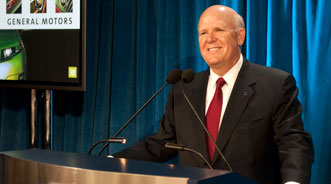Akerson: Product Transformation Key Element of GM Success

By subscribing, you agree to receive communications from Auto Remarketing and our partners in accordance with our Privacy Policy. We may share your information with select partners and sponsors who may contact you about their products and services. You may unsubscribe at any time.
DETROIT –
Addressing the automaker’s shareholders for the first time since General Motors’ initial public offering, GM top boss Dan Akerson described the Buick Verano and Chevrolet Sonic Z-spec sharing the stage with him Tuesday at Detroit’s Fisher Theatre as being “just the tip of the iceberg” of the company’s product transformation.
That metamorphosis, along with the automaker’s new-found “competitive dynamic,” have helped pushed GM to five consecutive quarters of profits.
While the product transformation wasn’t the only key cog cited in GM’s ongoing rebirth — the GM chief also delved into the automaker’s new business model, senior management team and global positioning, for instance — it certainly played a major role in GM’s recent success.
GM has instilled discipline in its product development and crafted a lineup that appeals to consumers, Akerson stressed.
“It starts and ends with beautifully styled, fuel-efficient cars, trucks and crossovers that our customers desire and deserve,” Akerson said at the beginning of his speech.
“How? By bringing more discipline to product development. We are creating more value … that customers are willing to pay for,” he stressed.
Subscribe to Auto Remarketing to stay informed and stay ahead.
By subscribing, you agree to receive communications from Auto Remarketing and our partners in accordance with our Privacy Policy. We may share your information with select partners and sponsors who may contact you about their products and services. You may unsubscribe at any time.
With the upcoming launches of the Verano, Sonic Z-spec and next-generation eAssist-equipped Chevrolet Malibu, GM has a “product cadence” that Akerson described as “the right vehicles at the right time.”
“These are two of the vehicles we’re launching this year,” the GM chief said of the two vehicles sharing the stage. “And the timing couldn’t be better.”
With gas up $1.30 from the same period of 2010, fuel efficiency is a core need for consumers who are crying out for gas-friendly vehicles.
And GM appears to be responding with the latest iterations in its lineup.
“Volt and Cruze were introduced late last year. Volt is in a category by itself. And last month, Cruze become the top-selling compact car in America last month,” Akerson said. “Add Sonic and Verano to the mix … and the next-generation Malibu with eAssist … and the product cadence we have is terrific.”
And the benefits of its product line and competitive dynamic are starting to show up on the bottom line.
He stressed that the results rising from the automaker’s products and competiveness serve as a foundation for success for GM, and attributed a good portion of the five-quarter string of profits to the fact that “we’re competitive now.”
The automaker pulled in $3.2 billion in first-quarter net income with EBIT-adjusted at $2 billion. GM generated $36 billion in revenues, marking a $4.7 billion year-over-year increase.
The automaker commanded 20.5 percent of the U.S. market in May, up from 20 percent the prior year. Retail share for GM came in at 17.7 percent, up from the pre-bankruptcy May 2009 level of 14.9 percent.
“And, we’re starting to see fair value for our products, meaning our average transaction prices are up,” Akerson noted.
In fact, he said the most recent average transaction price for GM tops among full-line OEMs at a little more than $29,500. Not only is No. 1 among GM and its peer, that figure outweighs the industry average by roughly $1,100, Akerson pointed out.
“And because we have a healthy balance sheet … because we aren’t shackled by a crippling cost structure, we have the freedom to re-invest in the business,” he continued.
GM’s "fortress balance sheet" included $36.5 billion in available liquidity as of March 31, and its debt was at $5 billion, Akerson said.
For instance, GM has added 9,000 jobs post-bankruptcy in the U.S., he noted. Furthermore, the automaker’s investments have totaled $3.4 billion in the past two-year time frame.
GM revealed in May that it would be pumping $2 billion more into its U.S. facilities, which the automaker believes will either generate or retain 4,000 additional jobs.
What’s more, Akerson cited the Center for Automotive Research data indicating that 28,000 other jobs will be supported by the U.S. facilities investment, which will also augment the nation’s GDP by almost $3 billion.
“And it doesn’t stop there. We’re doing lots of things behind the scenes to prepare for challenges known and unknown,” he stressed.
“When a shortstop makes a great play to throw out a runner, that doesn’t show up in the box score. All you see is an out,” Akerson continued. “We’re doing things you may not hear about, but we’re making plays all the same.”
Akerson counted several “plays” the automaker has made, including crafting a plan last year for the possibility $120/barrel oil; tackling risk head on with several measures; evaluating design, engineering and manufacturing footprints; and cutting complexities and wiping away expenses.
“Those are the kinds of things you would expect of any smart business,” Akerson stressed. “But we are pursuing larger goals at GM, too that will position us for long-term success: Creating a global dual-brand strategy with Cadillac and Chevrolet, flanked by regional brands in places like China, Australia and Europe. Making our European operations profitable and sustainable. Fully funding our US pensions.”
He continued: “The underfunded status has been reduced by about half since year-end 2009, when it was about $16 billion. Reaching a sustainable, competitive cost structure … These are the kinds of things we’re working on, every day, to make this company better, stronger, faster and more profitable.”
Akerson said the “new attitude” for what “really is a New GM” is as follows: “Expect to win, strive to win.”
Wrapping up the speech, he stated: “Our leadership team is steadfast in this, and resolved to move quickly and decisively to grow our business, to be more proactive, to anticipate change better than in the past, to look over the horizon more.
“With the people we now have, and the product mix we have and will have, I have no doubt we’ll succeed,” Akerson said.
Voting Results
In other news from the stockholders meeting, three ballot proposals were green-lighted by GM’s stockholders. This is the results of preliminary voting, which reflected 84.1 percent of eligible votes.
The first proposal was GM’s election of directors.
The 11 directors elected, each of which received 85.2 percent or more of the votes, are as follows:
1. Daniel Akerson
2. Stephen Girsky
3. David Bonderman
4. Erroll Davis, Jr.
5. E. Neville Isdell
6. Robert Krebs
7. Philip Laskawy
8. Kathryn Marinello
9. Patricia Russo
10. Carol Stephenson
11. Cynthia Telles
The second proposal, “Ratification of the selection of Deloitte & Touche LLP as the independent registered public accounting firm for GM and its subsidiaries for the year 2011,” was passed with 98.4 percent of the vote in favor.
The third, “Approval of the advisory proposal to approve executive compensation,” passed with 98.2 percent of the vote.


